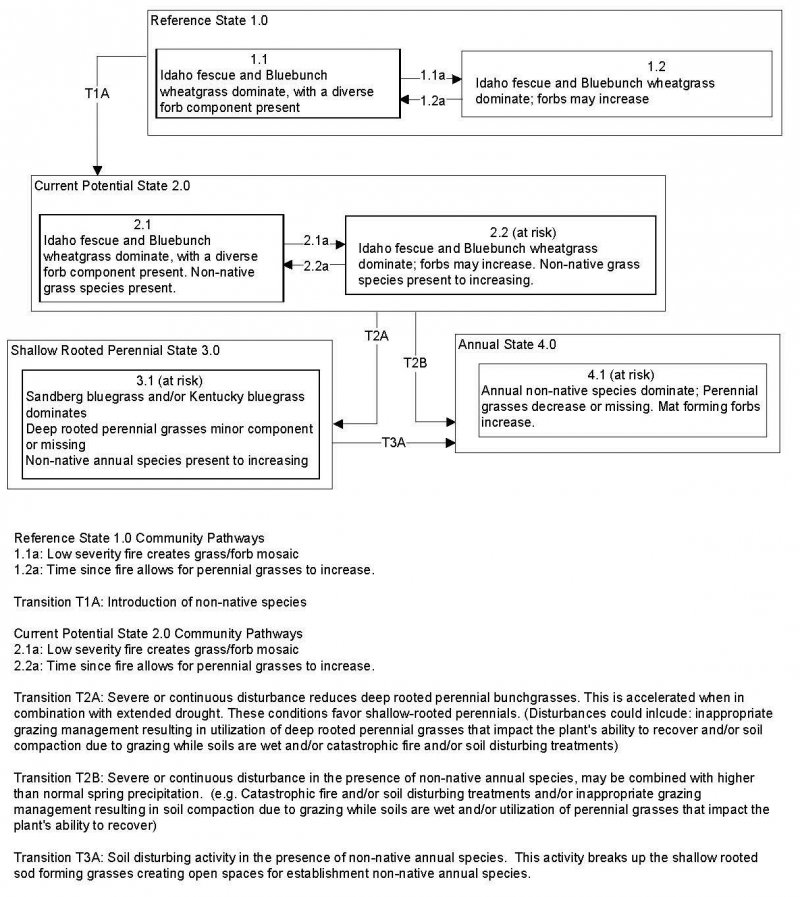
Natural Resources
Conservation Service
Ecological site R043CY802OR
Cool foothills and Mountains (FEID-KOMA-PSSPS)
Last updated: 3/31/2025
Accessed: 04/11/2025
General information
Provisional. A provisional ecological site description has undergone quality control and quality assurance review. It contains a working state and transition model and enough information to identify the ecological site.
MLRA notes
Major Land Resource Area (MLRA): 043C–Blue and Seven Devils Mountains
This MLRA covers the Blue and Seven Devils Mountains of Oregon, Washington and Idaho. The area is characterized by thrust and block-faulted mountains and deep canyons composed of sedimentary, metasedimentary, and volcanic rocks. Elevations range from 1,300 to 9,800 feet (395 to 2,990 meters). The climate is characterized by cold, wet winters and cool, dry summers. Annual precipitation, mostly in the form of snow, averages 12 to 43 inches (305 to 1,090 millimeters) yet ranges as high as 82 inches (2,085 millimeters) at upper elevations. Soil temperature regimes are predominately Frigid to Cryic and soil moisture regimes are predominately Xeric to Udic. Mollisols and Andisols are the dominant soil orders. Ecologically, forests dominate but shrub and grass communities may occur on south aspects and lower elevations as well as in alpine meadow environments. Forest composition follows moisture, temperature and elevational gradients and typically ranges from ponderosa pine and Douglas-fir plant associations at lower elevations, grand fir at middle elevations and subalpine fir and Engelman spruce at upper elevations. Historical fire regimes associated with these forest types range from frequent surface fires in ponderosa pine - Douglas Fir forest types to mixed and stand replacing fire regimes in grand fir and subalpine fir types. A large percentage of the MLRA is federally owned and managed by the U.S. Forest Service for multiple uses.
Classification relationships
Plant Assoc. of Blue and Ochoco Mountains (R6 E TP-036-92)
Idaho fescue-bluebunch wheatgrass - GB59
Plant Assoc. of Wallowa-Snake Province (R6 E 255-86)
Idaho fescue-prairie junegrass (ridge) - GB5911
Idaho fescue-prairie junegrass (mound) - GB5912
Idaho fescue-prairie junegrass (high elevation) - GB5913
Idaho fescue-bluebunch wheatgrass (ridge) - GB5915
Idaho fescue-bluebunch wheatgrass-arrowleaf balsamroot - GB5917
USDA Forest Service Ecological Sub-region
M332 “Blue Mountains”
U.S. National Vegetation Classification Standard (NVCS)
Group: G273. Central Rocky Mountain Lower Montane, Foothill & Valley Grassland
Alliance: A3988. Festuca idahoensis - Pseudoroegneria spicata - Pascopyrum smithii Mesic Grassland Alliance
Association: CEGL001620. Festuca idahoensis - Koeleria macrantha Grassland
Ecological site concept
This site occurs on upland plateaus, mountainslopes and ridges with shallow to moderately deep soils over hard igneous extrusive geologies (basalt, andesite, rhyolite, tuff, etc.). In the reference state, the site is characterized by dominance of Idaho fescue (Festuca idahoensis). Bluebunch wheatgrass (Pseudoroegneria spicata), prairie junegrass (Koeleria macrantha) and Sandberg bluegrass (Poa secunda) may also be found in significant amounts depending on soil depth, rock fragment content and overall available water capacity. Precipitation comes in the form of snow and rain primarily in the winter and early spring. Historically, plant community dynamics were driven primarily by disturbances such as localized fire and drought. Soil temperature regimes are typically frigid (although some mesic correlations currently exist). Soil moisture regimes are xeric.
This ecological site and its associated plant communities cover a broad range of elevations, soil climate regimes and soil depth classes. Further investigation will be needed to separate differences between these groups.
This is a provisional ecological site that groups characteristics at a broad scale with little to no field verification and is subject to extensive review and revision before final approval. All data herein was developed using existing information and literature and should be considered provisional and contingent upon field validation prior to use in conservation planning.
Associated sites
| R043CY807OR |
Scabland (PSSPS-POSE-DAUN) Occupying adjacent scabland areas with very shallow soil |
|---|
Similar sites
| R043CY806OR |
Very Shallow Scabland (ARRI2/PSSPS-POSE) Dominantly very shallow soils with lower overall production. PSSPS/POSE dominant rather than FEID. |
|---|---|
| R043CY804OR |
Cool Mountain Bunchgrass (ARTRV/FEID) Influenced by continental climate patterns, ARTRV common |
Table 1. Dominant plant species
| Tree |
Not specified |
|---|---|
| Shrub |
Not specified |
| Herbaceous |
(1) Festuca idahoensis |
Click on box and path labels to scroll to the respective text.
| T1A | - | Introduction of non-native plant species |
|---|---|---|
| T2A | - | Severe or continuous disturbance, such as prolonged improperly managed grazing |
| T2B | - | Severe or continuous disturbance, such as prolonged improperly managed grazing, catastrophic fire, or soil disturbing treatments, in the presence of invasive plant species |
| T3A | - | Soil disturbing activities in the presence of invasive plant species |
